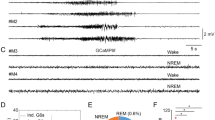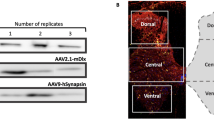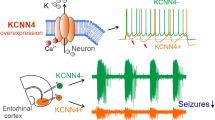Abstract
Herpes simplex virus type-1 (HSV) amplicon vectors containing neuroprotective genes can alter cell physiology and enhance survival following various insults. However, to date, little is known about effects of viral infection itself (independent of the gene delivered) on neuronal physiology. Electrically-evoked synaptic responses are routinely recorded to measure functional alterations in the nervous system and were used here to assess the potential capability of HSV vectors to disrupt physiology of the hippocampus (a forebrain structure involved in learning that is highly susceptible to necrotic insult, making it a frequent target in gene therapy research). Population excitatory post-synaptic potentials (EPSPs) were recorded in the dentate gyrus (DG) and in area CA3 in vivo 72 h after infusion of an HSV vector expressing a reporter gene (lacZ) or vehicle into the DG. Evoked perforant path (PP-DG) or mossy fiber (MF-CA3) EPSPs slope values measured across input/output (I/O) curves were not altered by infection. Paired-pulse facilitation at either recording site was also unaffected. X-gal-positive granule cells surrounded the recording electrode (PP-DG recording) and stimulating electrode tracts (MF-CA3 recording) in animals that received vector, suggesting that we had measured function, at least in part, in infected neurons. Because of the negative electrophysiological result, we sought to deliver a gene with an HSV amplicon which would affect the measured endpoints, as a positive control. Delivery of calbindin D28kpotentiated PP-DG synaptic strength, indicating that our recording system could detect alterations due to vector expression. Thus, the data indicate that HSV vectors are benign, in regard to effects on synaptic function, and support the use of these vectors as a safe method to deliver selected genes to the central nervous system.
This is a preview of subscription content, access via your institution
Access options
Subscribe to this journal
Receive 12 print issues and online access
$259.00 per year
only $21.58 per issue
Buy this article
- Purchase on Springer Link
- Instant access to full article PDF
Prices may be subject to local taxes which are calculated during checkout



Similar content being viewed by others
References
Ho DY et al. Defective herpes simplex virus vectors expressing the rat brain glucose transporter protect cultured neurons from necrotic insults J Neurochem 1995 65: 842–850
Lawrence MS, Ho DY, Dash R, Sapolsky RM . A Herpes simplex virus vectors overexpressing the glucose transporter gene protect against seizure-induced neuron loss Proc Natl Acad Sci USA 1995 92: 7247–7251
Dash R, Lawrence M, Ho D, Sapolsky R . A herpes simplex virus vector overexpressing the glucose transporter gene protects the rat dentate gyrus from an antimetabolite toxin Exp Neurol 1996 137: 43–48
Lawrence MS et al. Overexpression of the glucose transporter gene with a herpes simplex viral vector protects striatal neurons against stroke J Cereb Blood Flow Metab 1996 16: 181–185
Kindy M et al. Adenoviral vectors in ischemic injury. In: Krieglstein J (ed). Pharmacology of Cerebral Ischemia Medpharm: Stuttgart 1996 111–122
Meier TJ, Ho DY, Sapolsky RM . Increased expression of calbindin D28k via herpes simplex virus amplicon vector decreases calcium ion mobilization and enhances neuronal survival after hypoglycemic challenge J Neurochem 1997 69: 1039–1047
Meier TJ, Ho DY, Park TS, Sapolsky RM . Gene transfer of calbindin D28k cDNA via herpes simplex virus amplicon vector decreases cytoplasmic calcium ion response and enhances neuronal survival following glutamatergic challenge but not following cyanide J Neurochem 1998 71: 1013–1023
Fink SL, Chang LK, Ho DY, Sapolsky RM . Defective herpes simplex virus vectors expressing the rat brain stress-inducible heat shock protein 72 protect cultured neurons from severe heat shock J Neurochem 1997 68: 961–969
Yenari MA et al. Gene therapy with HSP72 is neuroprotective in rat models of stroke and epilepsy Ann Neurol 1998 44: 584–591
Linnik MD, Zahos P, Geschwind MD, Federoff HJ . Expression of bcl-2 from a defective herpes simplex virus-1 vector limits neuronal death in focal cerebral ischemia Stroke 1995 26: 1670–1674; discussion 1675
Jia WW et al. A bcl-2 expressing viral vector protects cortical neurons from excitotoxicity even when administered several hours after the toxic insult Brain Res Mol Brain Res 1996 42: 350–353.
Lawrence MS et al. Overexpression of Bcl-2 with herpes simplex virus vectors protects CNS neurons against neurological insults in vitro and in vivo J Neurosci 1996 16: 486–496
Lawrence MS et al. Herpes simplex viral vectors expressing Bcl-2 are neuroprotective when delivered after a stroke J Cereb Blood Flow Metab 1997 17: 740–744
Xu DG et al. Elevation of neuronal expression of NAIP reduces ischemic damage in the rat hippocampus Nature Med 1997 3: 997–1004
Betz AL, Yang GY, Davidson BL . Attenuation of stroke size in rats using an adenoviral vector to induce overexpression of interleukin-1 receptor antagonist in brain J Cereb Blood Flow Metab 1995 15: 547–551
Hagan P et al. Adenovirus-mediated over-expression of interleukin-1 receptor antagonist reduces susceptibility to excitotoxic brain injury in perinatal rats Neurosci 1996 75: 1033–1045
Chiocca EA et al. Transfer and expression of the lacZ gene in rat brain neurons mediated by Herpes simplex virus mutants New Biol 1990 2: 739–746
Dobson AT et al. A latent, nonpathogenic HSV-1-derived vector stably expresses β-galactosidase in mouse neurons Neuron 1990 5: 353–360
Geller AI, Keyomarski K, Bryan J, Pardee AB . An efficient deletion mutant packaging system for defective herpes simplex virus vectors: potential applications to human gene therapy and neuronal physiology Proc Natl Acad Sci USA 1990 87: 8950–8954.
Kaplitt MG et al. Expression of a functional foreign gene in adult mammalian brain following in vivo transfer via a herpes simplex virus type 1 defective viral vector Mol Cell Neurosci 1991 2: 320–330
Johnson PA et al. Cytotoxicity of a replication-defective mutant of herpes simplex virus type 1 J Virol 1992 66: 2952–2965
Johnson PA, Yoshida K, Gage FH, Friedmann T . Effects of gene transfer into cultured CNS neurons with a replication-defective herpes simplex virus type 1 vector Mol Brain Res 1992 12: 95–102
Wood MJ et al. Specific patterns of defective HSV-1 gene transfer in the adult central nervous system: implications for gene targeting Exp Neurol 1994 130: 127–140
Ho DY et al. Herpes simplex virus vector system: analysis of its in vivo and in vitro cytopathic effects J Neurosci Met 1995 57: 205–215
Jia WW, Tan J, Redekop GJ, Goldie JH . Toxicity studies in thymidine kinase-deficient herpes simplex virus therapy for malignant astrocytoma J Neurosurg 1996 85: 662–666
During MJ, Naegele JR, O’Malley KL, Geller AI . Long-term behavioral recovery in parkinsonian rats by an HSV vector expressing tyrosine hydroxylase Science 1994 266: 1399–1403
Bergold PJ, Casaccia-Bonnefil P, Zeng XL, Federoff HJ . Transsynaptic neuronal loss induced in hippocampal slice cultures by a herpes simplex virus vector expressing the GluR6 subunit of the kainate receptor Proc Natl Acad Sci USA 1993 90: 6165–6169
Ho DY, Mocarski ES, Sapolsky RM . Altering central nervous system physiology with a defective herpes simplex virus vector expressing the glucose transporter gene Proc Natl Acad Sci USA 1993 90: 3655–3659
Kaplitt MG et al. Long-term gene expression and phenotypic correction using adeno-associated virus vectors in the mammalian brain Nat Genet 1994 8: 148–154
Howard MK et al. High efficiency gene transfer to the central nervous system of rodents and primates using herpes virus vectors lacking functional ICP27 and ICP34.5 Gene Therapy 1998 5: 1137–1147
Chard PS et al. Regulation of excitatory transmission at hippocampal synapses by calbindin D28k Proc Natl Acad Sci USA 1995 92: 5144–5148
Bayer SA . Development of the hippocampal region in the rat I. neurogenesis examined with 3H-thymidine autoradiography J Comp Neurol 1980 190: 87–114
Fenwick M . The effect of herpes viruses on cellular macromolecular synthesis Comp Virol 1984 19: 359–390
Heilbronn R, zur Hausen H . A subset of Herpes simplex virus replication genes induces DNA amplification within the host cell genome J Virol 1989 63: 3683–3692
Kwong AD, Frenkel N . The Herpes simplex virus virion host shutoff function J Virol 1989 63: 4834–4839
Cantin EM, Hinton DR, Chen J, Openshaw H . Gamma interferon expression during acute and latent nervous system infection by herpes simplex virus type 1 J Virol 1995 69: 4898–4905
Halford WP, Gebhardt BM, Carr DJ . Persistent cytokine expression in trigeminal ganglion latently infected with herpes simplex virus type 1 J Immunol 1996 157: 3542–3549
Liu T, Tang Q, Hendricks RL . Inflammatory infiltration of the trigeminal ganglion after herpes simplex virus type 1 corneal infection J Virol 1996 70: 264–271
Plata-Salamán CR, Ffrench-Mullen JM . Interleukin-1 beta inhibits Ca2+ channel currents in hippocampal neurons through protein kinase C Eur J Pharmacol 1994 266: 1–10
Yu B, Shinnick-Gallagher P . Interleukin-1 beta inhibits synaptic transmission and induces membrane hyperpolarization in amygdala neurons J Pharmacol Exp Ther 1994 271: 590–600
Cunningham AJ et al. Interleukin-1 beta (IL-1 beta) and tumour necrosis factor (TNF) inhibit long-term potentiation in the rat dentate gyrus in vitro Neurosci Lett 1996 203: 17–20
Coogan A, O’Connor JJ . Inhibition of NMDA receptor-mediated synaptic transmission in the rat dentate gyrus in vitro by IL-1 beta NeuroRep 1997 8: 2107–2110
Li AJ et al. Interleukin-6 inhibits long-term potentiation in rat hippocampal slices Brain Res 1997 748: 30–38
Murray CA, Lynch MA . Evidence that increased hippocampal expression of the cytokine interleukin-1 beta is a common trigger for age- and stress-induced impairments in long-term potentiation J Neurosci 1998 18: 2974–2981
Pauli S, Linthorst AC, Reul JM . Tumour necrosis factor-alpha and interleukin-2 differentially affect hippocampal serotonergic neurotransmission, behavioural activity, body temperature and hypothalamic-pituitary-adrenocortical axis activity in the rat Eur J Neurosci 1998 10: 868–878
Song S et al. Modulation of rat rotational behavior by direct gene transfer of constitutively active protein kinase C into nigrostriatal neurons J Neurosci 1998 18: 4119–4132
Wu L-G, Saggau P . Presynaptic calcium is increased during normal synaptic transmission and paired-pulse facilitation but not in long-term potentiation in area CA1 of hippocampus J Neurosci 1994 14: 645–654
Ho DY . Amplicon-based herpes simplex virus vectors Metab Cell Biol 1994 43: 191–210
DeLuca NA, McCarthy AM, Schaffer PA . Isolation and characterization of deletion mutants of herpes simplex virus type I in the gene encoding immediate-early regulatory protein ICP4 J Virol 1985 56: 558–570
Creager R, Dunwiddie T, Lynch G . Paired-pulse and frequency facilitation in the CA1 region of the in vitro rat hippocampus J Physiol 1980 299: 409–424
Acknowledgements
The authors would like to thank Dr HC Heller, V Cao and L Giuli for their generosity, technical expertise and related efforts. This study was supported by NIH5T32-NS07280 (Epilepsy Training Grant fellowship) to TC Dumas and NS32848 to RM Sapolsky.
Author information
Authors and Affiliations
Rights and permissions
About this article
Cite this article
Dumas, T., McLaughlin, J., Ho, D. et al. Delivery of herpes simplex virus amplicon-based vectors to the dentate gyrus does not alter hippocampal synaptic transmission in vivo. Gene Ther 6, 1679–1684 (1999). https://doi.org/10.1038/sj.gt.3300997
Received:
Accepted:
Published:
Issue Date:
DOI: https://doi.org/10.1038/sj.gt.3300997



